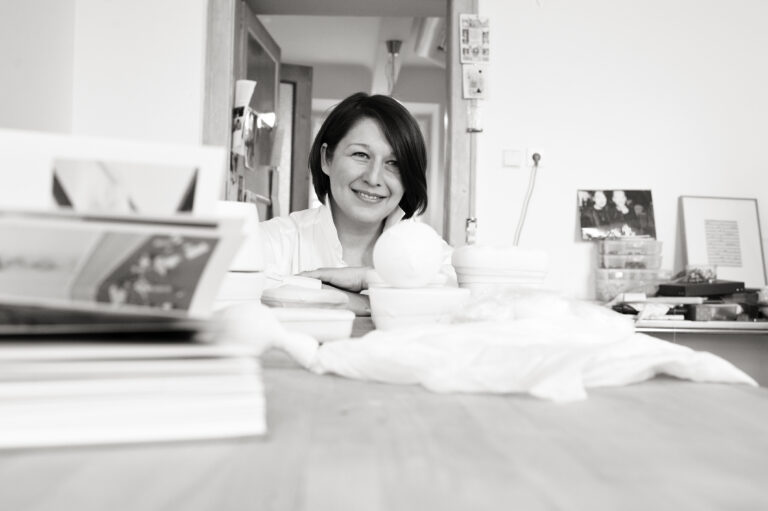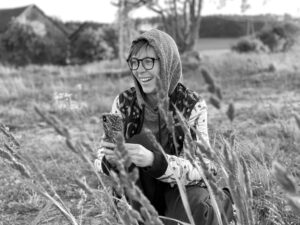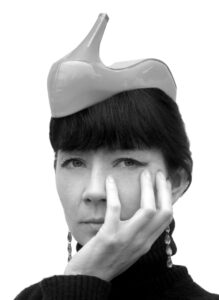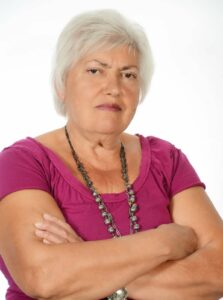Denisa Lehocká

– born in 1971 in Trenčín, Czechoslovakia. She lives and works in Bratislava, Slovakia. She studied at the Secondary School of Arts and Crafts and subsequently at the Academy of Fine Arts, both in Bratislava. Among many other venues she has exhibited at the Venice and Prague Biennials, as well as Manifesta-3 in Ljubljana (SI) and October Salon, Belgrade (SRB), Badischer Kunstverein, Karlsruhe (DE), Kunstverein Ulm (DE), Frankfurter Kunstverein (DE), Württembergische Kunstverein, Stuttgart (DE), Import a HKW (Transmediale), Berlin (DE), BAK Basis voor Actuele Kunst, Utrecht (NL), New Museum, NYC (USA), Austrian Cultural Forum, NYC (USA), DUMBO Art Cener, NYC (USA), White Columns, NYC (USA), in SNG, Bratislava (SK), tranzit.sk, Bratislava (SK), National Gallery in Prague (CZ), Futura, Prague (CZ) and Fait Gallery, Brno (CZ), Museum of Modern Art, St Etienne (F) Sammlung Friedrichshof, Vienna (AT), MUMOK — Stiftung Ludwig Vienna (AT), Kunsthaus Graz Landesmuseum Joanneum, Graz (AT), Palazzo delle arti Napoli, Naples (IT), Kunsthalle Basel, Basel (CH), Kunsthaus Bern (CH).
Creation is to me an essential activity. I can also call it breathing. I am mapping my space-time, both inner and outer. Imaginary landscapes.
I am interested in expression means both artistic and design. I would like I am interested in expression means both artistic and design. I would like to bring an emotional experience rather than knowledge – something from worlds where formal language is still lacking to reach. Semi-abstractness is a liberation from literality, which is always limiting not only for me but also for the viewer. This liberation is a long-term job.
I am working spontaneously in one flow. This flow is, of course, interrupted by the duties of everyday life. I am not just an artist, but I have a lot of other roles. And I am always looking back critically. I am never satisfied. Nothing is ever done. I am always sensitive to challenges, impulses. I am most interested in such problematic issues as Everything and Truth.
Time also plays an important role in my work. I am working a lot with Time also plays an important role in my work. I am working a lot with transitional states. Everydayness is to me essential as another kind of temporality. The ritual of regularity is also essential for me. It gives my life an order, a sense of security and creates a part of its meaning. It takes me years to complete certain artworks1. For me, creation as a diary entry is not a conceptual position, but a natural secondary product of regularity, of being itself. It is a kind of home that exists and still is evolving. Home is essential to me.
My work with space is based on long-term observations and experiences so can I rely on my intuition. It is like an analysis of the whole space, all iMy work with space is based on long-term observations and experiences so can I rely on my intuition. It is like an analysis of the whole space, all its components, its atmospheres, the light, in my case without any computer assistance. It is a kind of averaging of all attributes and then the deduction of the location in the architecture itself. For me, the space of any exhibition is the same as a blank paper before drawing. But even that blank paper has some grid, texture, frame, volume.
The drawing2 is perhaps the most preparatory, first phase, available everywhere. But for me, all images and objects or their installations are equal, regardless of whether it is just a notation, note, sketch. Materials34 themselves are the carriers of meanings. The cotton sheet56 is not a neutral base, it has a very difficult history and connotations.
I cannot identify with the limited understanding of any political matter as a public activism. Everything which goes beyond my limits is political to me, which means work with people and for them, Thus, art itself is political only by its publication.
Just as I do not express myself narratively and what I consider political is not what is a loudly present in the middle of the square, I similarly perceive my personal non-manifestative position in the spectrum of feminism. I am in for complete, all-inclusive freedom of self-determination.
Sometimes I am really bothered by the characteristic of “female”. Is “male” art ever discussed at all? If I must say, unless femininity, sensitivity, sensuality is degraded to something “nice”, “pretty”, “fragile”, “weak” or even “hysterical”, then each of these expressions can express the power of corporeality and the historical transformation of female position. I cannot see it as a question of identification. I perceive it as given, as something I have no chance not to work on.
The text was written in collaboration with Michaela Kučová (2021).
1Image: Denisa Lehocká, Untitled, 2014-2016, acrylic paint, pencil, Indian ink, ceramic beads on cotton blanket, plaster-textile, ceramic-beads object on Eames Vitra "Plastic chair". Courtesy of the artist.2Image: Denisa Lehocká, Untitled, 2017, cotton threads, ink, pencil, nylon and other materials on paper, A3, photo author's archive. Courtesy of the artist.
3Image: Denisa Lehocká, Untitled, 2013, plaster, cotton and various materials, Sammlung Friedrichshof, photo: Jiří Thýn. Courtesy of the artist.
4Image: Denisa Lehocká, Untitled, 2013, plaster, cotton and various materials, Sammlung Friedrichshof, photo Jiří Thýn. Courtesy of the artist.
5Image: Denisa Lehocká, Untitled, 2011, cotton sheet, thread, shot from the exhibition of Denisa Lehocká & Boris Ondreička, Try to describe the color of pure (still) water, my dear, Badischer Kunstverein, photo Stephan Baumann, bild_raum. Courtesy of the artist.
6Image: Denisa Lehocká, Untitled, 2011, cotton sheet, thread, shot from the exhibition of Denisa Lehocká & Boris Ondreička, Try to describe the color of pure (still) water, my dear, Badischer Kunstverein, photo: Stephan Baumann, bild_raum. Courtesy of the artist.
– sa narodila 1971 v Trenčíne, Československo. Žije a pracuje v Bratislave,
Slovensko. Študovala Strednú umelecko-priemyselnú školu a následne Vysokú školu výtvarných umení, obe v Bratislave. Mimo mnohých svoje práce vystavovala na Benátskom a Pražskom bienále, ako aj Manifesta-3 v Ljubljane (SI), a October Salon, Belehrad (SRB), v Badischer Kunstverein, Karlsruhe (DE), Kunstverein Ulm (DE), Frankfurter Kunstverein (DE), Württembergische Kunstverein, Stuttgart (DE), Import a HKW (Transmediale), Berlin (DE), BAK Basis voor Actuele Kunst, Utrecht (NL), New Museum, NYC (USA), Austrian Cultural Forum, NYC (USA), DUMBO Art Cener, NYC (USA), White Columns, NYC (USA), v SNG, Bratislava (SK), tranzit.sk, Bratislava (SK), Národní galerie v Prahe (CZ), Futura, Praha (CZ) a Fait Gallery Brno (CZ), Museum of Modern Art, St Etienne (F), Sammlung Friedrichshof, Vienna (AT), MUMOK—Stiftung Ludwig Vienna (AT), Kunsthaus Graz Landesmuseum Joanneum, Graz (AT), Palazzo delle arti Napoli, Naples (IT), Kunsthalle Basel, Basel (CH), Kunsthaus Bern (CH).
Tvorba je pre mňa bytostná činnosť. Nazývam to aj dýchaním. Mapujem svoj časopriestor, ako vnútorný, tak vonkajší. Pomyselné krajiny.
Zaujímajú ma výrazové prostriedky ako umelecké, tak dizajnérske. Chcem prinášať skôr emočnú skúsenosť, zážitok, než znalosti. Niečo zo svetov, kde ešte chýba formálny jazyk. Poloabstraktnosť je oslobodenie sa od doslovnosti, ktorá je vždy obmedzujúca, ako pre mňa, tak pre diváka. Toto oslobodenie je dlhodobá práca.
Pracujem, možno by som mohla tvrdiť, spontánne, v jednom toku. Ten je samozrejme prerušovaný povinnosťami obyčajného života. Nie som len umelkyňa, ale všeličo možné. A vždy sa ohliadam kriticky späť. Nikdy nie som spokojná. Nič nie je dokončené. Vždy som citlivá na výzvy, impulzy. Najviac ma zaujímajú tak problematické veci ako Všetko a Pravda.
Čas v mojej práci zohráva významnú rolu. Veľa pracujem s prechodnými Čas v mojej práci zohráva významnú rolu. Veľa pracujem s prechodnými skupenstvami. Iný (pre mňa podstatný) druh časovosti je každodennosť. Rituálna pravidelnosť je pre mňa zásadná. Dáva môjmu životu poriadok, pocit istoty a aj časť jeho zmyslu. Dokončenie niektorých prác mi trvá aj roky1. Tvorba ako denníkový záznam pre mňa nie je konceptuálna poloha, ale prirodzený druhotný produkt pravidelnosti, bytostnosti. Je to akýsi domov, ktorý je a aj sa vyvíja. Domov je pre mňa podstatný.
S priestorom pracujem na základe dlhodobých pozorovaní, skúseností a tak sa opieram o intuíciu. Je to niečo ako rozbor celého priestoru, S priestorom pracujem na základe dlhodobých pozorovaní, skúseností a tak sa opieram o intuíciu. Je to niečo ako rozbor celého priestoru, všetkých komponentov, atmosfér, svetla, ale v mojom prípade bez počítačovej asistencie. Je to akési spriemerovanie všetkých atribútov a potom samotné vyvodenie umiestnenia v architektúre. Priestor robenia výstavy je pre mňa vlastne taký istý ako prázdny formát papiera pred kreslením. Ale už aj ten prázdny papier má nejakú mriežku, textúru, rámec, objem.
Kresba2 je možno najprípravnejšia, najprvšia, všade k dispozícii. Všetky obrazy a objekty či ich inštalácie ale pre mňa sú rovnocenné bez ohľadu na to, či je to len zápis, poznámka, skica. Materiály34 sú pre mňa už samé nositeľmi významov. Bavlnená plachta56 nie je neutrálny podklad, nesie v sebe históriu aj veľmi veľa ťažkých súvislostí.
Naozaj sa nedokážem stotožniť s obmedzeným chápaním politického ako verejného aktivizmu. Politické je pre mňa všetko robenie mimo hranice mňa samej, je to práca s ľuďmi, pre ľudí. Tým pádom je umenie samosebou politické už len svojím zverejnením.
Tak ako sa nevyjadrujem naratívne a za politické považujem širokú škálu nie nevyhnutne hlasno prítomnú v strede námestia, tak vnímam aj moju osobnú nemanifestatívnu pozíciu v spektre feminizmu. Som za úplnú, vše-inkluzívnu slobodu sebaurčenia.
Niekedy ma popravde otravuje charakteristika „ženské“. Diskutuje sa vôbec niekedy o „mužskom“ umení? Keď musím, tak pokiaľ sa ženskosť, citlivosť, senzualita nedegradujú na niečo „milé“, „pekné“, „krehké“, „slabé“ či dokonca „hysterické“, tak každý z týchto výrazov môže vyjadrovať silu telesnosti a historické premeny jej postavenia. Nie je to pre mňa otázka stotožnenia sa. Vnímam to ako dané, ako niečo s čím nemám šancu nepracovať.
Text bol napísaný v spolupráci s Michaelou Kučovou (2021).
Michaela Kučová – sa narodila v roku 1988. Venuje publicistike, projektovému manažmentu a PR v oblasti kultúry. Spolupracovala na projektoch ako PechaKucha Night Bratislava, Dymová hora, Cena Oskára Čepana, Biela noc či Question of Will. V galérii Art Books Coffee dva roky viedla sériu diskusií o rodových témach v slovenskom umení. Jej texty ste mohli čítať aj v SME, Denníku N, Pravde, Profile, Artalku či Kapitáli. Prispela do katalógov Kristíny Mésároš či Výročnej výstavy VŠVU Take Care. Je spoluzakladateľkou feministického newslettra Kurník.
1Obrázok: Denisa Lehocká, Untitled, 2014-2016, akrylová farba, ceruzka, indický atrament, keramické korálky na bavlnenej deke, sádro-textil, predmet z keramických korálkov na „Plastovej stoličke“ Eames Vitra. S láskavým dovolením umelkyne.2Obrázok: Denisa Lehocká, Untitled, 2017, bavlnené nite, tuš, ceruzka, nylón a iné materiály na papieri, a3, foto archív autorky. S láskavým dovolením umelkyne.
3Obrázok: Denisa Lehocká, Untitled, 2013, sadra, bavlna a rôzne materiály, Sammlung Friedrichshof, foto: Jiří Thýn. S láskavým dovolením umelkyne.
4Obrázok: Denisa Lehocká, Untitled, 2013, sadra, bavlna a rôzne materiály, Sammlung Friedrichshof, foto Jiří Thýn. S láskavým dovolením umelkyne.
5Obrázok: Denisla Lehocká, Untitled, 2011, bavlnena plachta, nite, záber z výstavy Denisa Lehocká &Boris Ondreička, Try to describe the colour of pure (still) water, my dear, Badischer Kunstverein, foto Stephan Baumann, bild_raum. S láskavým dovolením umelkyne.
6Obrázok: Denisla Lehocká, Untitled, 2011, bavlnena plachta, nite, záber z výstavy Denisa Lehocká &Boris Ondreička, Try to describe the colour of pure (still) water, my dear, Badischer Kunstverein, foto Stephan Baumann, bild_raum. S láskavým dovolením umelkyne.



